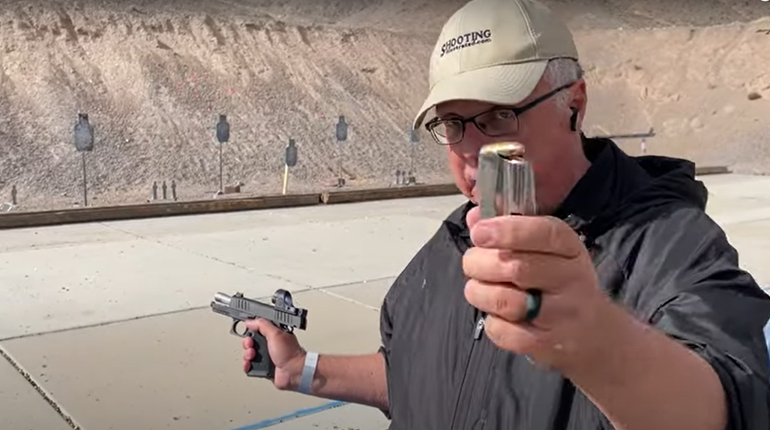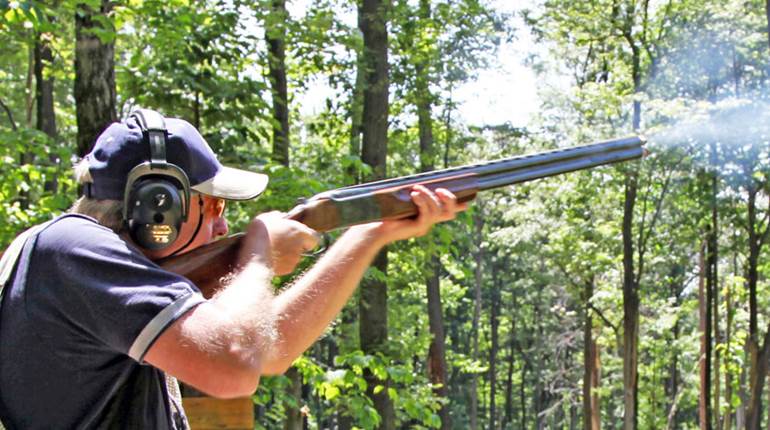
African rifles are more than just wood and steel. The genre is rich in romance, tradition and history including several important milestones of firearms development. African rifles served as the primary test-bed for the introduction of nitrocellulose gunpowder—modern smokeless powder—to sporting arms. When the blackpowder era was supplanted with smokeless, cartridges like the .500 (3¼ inch) were loaded with cordite and rechristened as “Nitro Express” cartridges.
The term “Nitro Express” derived from the “nitro” in nitrocellulose and “express” from the designation of much faster trains—express trains—that speeded up travel in Victorian England. Of course the Nitro Express cartridges produced much faster velocities than their blackpowder predecessors.
With the increased velocity of Nitro Express cartridges came increased chamber pressures which prompted gunmakers of the day to develop stronger, more robust rifle actions. These were side-by-side rifles, doubles, destined for the far-flung corners of the British Empire in the hands of officers and gentlemen of the realm.
Later, when Mauser perfected the bolt-action rifle, it was British gunmakers catering to the African trade who developed a sporting version of Mauser’s military rifle and introduced such classic cartridges as the .404 Jeffery, .416 Rigby and the granddaddy of all African cartridges, Holland’s .375 Magnum.
Then as now, African rifles fell into two classes: big-game rifles and plains-game rifles. “Big game” meant elephant, rhino and buffalo while plains game included all the antelopes and soft-skinned dangerous game. Naturally, the lines between the types of game that could be hunted with the respective classes of rifles often blurred, with the most extreme example being William Dalrymple Maitland Bell who shot 1,011 elephant with a .275 Rigby (exactly the same as a 7x57mm Mauser).
Generally speaking, in the heyday of African rifles big game was hunted with a double while plains game was hunted with a bolt-action, but there were exceptions. When President Roosevelt took his 1909 safari, he took a Holland & Holland Royal double, a .405 Winchester lever-action and a .30-’06 Springfield bolt-action. He proclaimed his .405 Win. to be “excellent lion medicine."
Today, African rifles still divide into big game and plains game categories. The action type is no longer demarcated as clearly as it was in the “champagne era” of safaris in the 1920s when only the very rich went on safari. A bolt-action is by far the dominant style for both categories today.
Plains-Game Rifles
Maybe we should call plains game rifles NOBER guns—Not Buffalo, Elephant or Rhino—because that’s really what we mean in this tremendously broad catch-phrase. The plains-game rifle deals with everything except those three thick-skinned, heavily boned animals. The category goes from 5 pound dik-dik to 2,000 pound eland. It includes game with tooth, fang, claw and horn. Soft-skinned dangerous game such as lion, leopard and hyena are included. Hippo and croc are often brain-shot with a plains-game rifle. The spectrum of plains game is truly vast.
Plains-game rifles can, in theory, include single-shots, doubles, slide-actions and lever-actions, but in practice, virtually everyone uses a bolt-action. About the only action type that’s never used, because they’re illegal in African countries, is a semi-automatic.
Bolt-action rifles dominate in the hands of both clients and professional hunters (PHs). The reasons are obvious: Bolt-actions are affordable, accurate, reliable and available in many different brands and calibers. Traditionalists will say that a Mauser action is the classic choice for Africa, and I wouldn’t disagree, however, there’s absolutely nothing wrong with other versions of the turn-bolt.
A long-running argument centers on the claw extractor and controlled-round feeding of a Mauser or Mauser-derived action. Jim Carmichael, the long-time Shooting Editor of Outdoor Life, decided to settle the matter of extractors once and for all by having a scientific tug-of-war between a Mauser claw and a Remington spring-loaded extractor.
Jim fashioned a .30-’06 extractor groove on both ends of a solid length of brass and then rigged up two hydraulic machines fitted with a Mauser and a Remington extractor on each end and began pulling. Guess which failed first?
Neither! The brass tore! Jim’s conclusion was that both types of extractor are literally stronger than the cartridge’s rim, so the whole debate is entirely moot.
Controlled-round feeding is another matter. When you push forward on the bolt to pick up a fresh cartridge from the magazine, the rim of a new round slips under a Mauser’s claw extractor so that the cartridge is “controlled” as it’s pushed into the chamber. If for some reason, the shooter pulls backward in mid-stroke, the round is still retained by a Mauser’s bolt, preventing a jam.
With a push-feed system, as the shooter shoves the bolt forward, it pushes a round out of the magazine and scoots it along into the chamber. If the shooter hesitates and pulls backward on the bolt before the round is chambered, at which time the extractor snaps over the rim to grab the cartridge, then a jam ensues.
Notice that the key here is the shooter—pilot error, in other words. There’s no problem with a push-feed system unless the shooter short-strokes the bolt. Because of that, I don’t think a push-feed action is any “worse” than a Mauser. It simply requires a shooter to handle to his rifle properly.
On the other hand, there’s an important argument against Mauser-derived actions that you hardly ever hear about. It has to do with the three-position safety made famous on the Winchester Model 70, which is the best known (and my personal favorite) of all the Mauser-derived actions.
The three-position safety gives the shooter the option of blocking the sear and locking the bolt handle down (the safety all the way to rear), blocking the sear but allowing the bolt handle to be raised (middle position) or disengaging the safety entirely (all the way forward). The theory behind the middle position is that the round in the chamber can be unloaded even while the sear is blocked, hence it’s “more safe” than a Mauser two-position safety.
The rub is that if the bolt is slightly lifted while the safety is in the middle position—which can easily happen in the field—the safety becomes locked! You can’t push it forward to “fire.” For this reason, I never use the middle position while hunting.
Given that there’s pros and cons to all the various brands of bolt-action rifles, you have a lot of good choices available. My favorite is the rifleman’s rifle, Winchester’s immortal Model 70 in both pre-64 and the reintroduced “classic” versions. However, I have several push-feed rifles in my African battery including Sako, Sauer, Ruger, Ed Brown, Ultra Light Arms and Remington. Hunt with what you like and don’t let anyone try to tell you that a Mauser is “better.”
Caliber Choices
Plains-game calibers are almost as diverse as the gamut of game that can be hunted with them. You can start with a .22 Hornet and, without stretching things, go up to .416 Rigby. I once shot sable, warthog, reedbuck and all my plains game on Mozambique safari with a .458 Win. Mag., but that was definitely a case of being over-gunned.
I’ve made it a point to ask PHs what calibers they like to see clients bring and, over the years, there have been two hands-down favorites: .300 Win. Mag. and .375 H&H Magnum. Of course these guys all agreed that a client should bring the gun that he or she shoots the best, regardless of caliber. Accuracy comes first.
The .30 caliber is my all-time favorite plains-game bore size. I’ve hunted with rifles in .308 Win., .30-’06, .300 Win. Mag. and my favorite, the .300 H&H Mag. Given the “right bullet”—which is my secret way of saying “Barnes X”—you can kill anything in Africa other than thick-skinned game with a .30 caliber.
I really like the .300 H&H loaded with 180 grain Barnes TSX bullets. I have a pre-war Model 70 in “.300 Magnum” which was the marking Winchester used for the .300 H&H prior to the introduction of the .300 Win. Mag. I also have a “classic” Model 70 in .300 H&H which was custom built by Sterling Davenport—a sweet rifle. The .300 H&H appeals to me because it’s such a vintage African caliber even though any of the .300 magnums—short, ultra or in between—equal or surpass its velocity.
No question, the .375 H&H is the best all-around choice for Africa, plains game and big game included. With a solid bullet, a .375 is fine for elephant. I shot my first lion with a Sako .375 H&H using a 285 grain. Speer Grand Slam. Today I own three .375s, the most duplicates of any caliber in my African collection.
Confession time—I really, really don’t like any of the super short or fat ultra cartridges. I don’t own a single one and never will. The WSM line are all short and stubby and therefore have inherent feeding problems. I see the various ultra mags as needless repetition. If you simply want lots of velocity, Roy Weatherby took care of that with the immortal .300 Wthby. Mag., which is a classic itself.
African rifles are steeped in romance and nostalgia, and so should their calibers. Avoid anything that’s too modern, and go with old favorites like Bell’s 7x57, Holland’s venerable .300 and .375 Magnums or Roosevelt’s pet .30-’06. I’ve even hunted with O’Connor’s darling, the .270 Win. (with “the right bullet” of course).
Pick your favorite classic caliber and take it to Africa for your plains-game rifle. You’ll shoot it well, enormously satisfying your PH, and you’ll enjoy your safari even more knowing that you’re using a great old caliber and pet rifle.





































